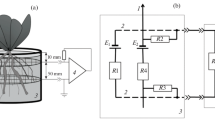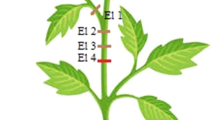Abstract
The electric potential on the surface of the Lepidium sativum L. root apex was recorded by means of six non-polarizable electrodes. Nonevoked fluctuations of the potential with amplitudes below 0.1 mV were observed. The fluctuations could be reversibly inhibited either by ether vapor or by anoxia caused by N2. They did not occur in killed roots. Cross-correlation analysis of the fluctuations from six electrodes located one above another along the 3-mm apical region showed a pattern of time delay which indicates that the fluctuations may be the consequence of signals propagated in the root with a velocity of 3–9 mm · s−1 in a basipetal direction from the root cap. We hypothesize that the fluctuations are due to signals of an unknown nature propagated along an intrasymplasmic continuous system, the “symreticulum”, composed of the cortical ER of individual cells and desmotubules passing through the plasmodesmata.
Similar content being viewed by others
Abbreviations
- AC:
-
alternating current
- AP:
-
action potential
- ACF:
-
autocorrelation function
- CCF:
-
cross-correlation function
- DC:
-
direct current
- EEP:
-
extracellular electric potential
References
Behrens, H.M., Gradmann, D. (1985) Electrical properties of the vertically growing root tip of Lepidium sativum L. Planta 163, 453–462
Behrens, H.M., Weisenseel, M.H., Sievers, A. (1982) Rapid changes in the pattern of electric current around the root tip of Lepidium sativum L. following gravistimulation. Plant Physiol. 70, 1079–1083
Behrens, H.M., Gradmann, D., Sievers, A. (1985) Membranepotential responses following gravistimulation in roots of Lepidium sativum L. Planta 163, 463–472
Davies, A. (1987) Action potentials as multifunctional signals in plants: a unifying hypothesis to explain apparently disparate wound responses. Plant Cell Environ. 10, 623–631
De Greef, J.A., Caubergs, R., Verbelen, J.-P., Moereels, E. (1976) Phytochrome-mediated interorgan dependency and rapid transmission of the light stimulus. In: Light and plant development, pp. 295–316, Smith, H., ed. Butterworths, London
Erickson, R.O. (1986) Symplastic growth and symplasmic transport. Plant Physiol. 82, 1153
Fitting, H. (1905) Untersuchungen über den geotropischen Reizvorgang. Jahrb. Wissenschaftl. Bot. 41, 221–330, 331–398
Frachisse, J.-M., Desbiez, M.-O., Champagnat, P., Thellier, M. (1985) Transmission of a traumatic signal via a wave of electric depolarization, and induction of correlations between the cotyledonary buds in Bidens pilosus. Physiol. Plant. 64, 48–52
Glebicki, K., Hejnowicz, Z., Pijanowski, A. (1986) Localized spontaneous fluctuations of electric potential in shoots of different plants. Acta Soc. Bot. Pol. 55, 67–76
Glebicki, K., Hejnowicz, Z., Pijanowski, A. (1989) Induced fluctuations of electric potentials in the apoplast of leaves. Planta 180, 1–4
Hecks, B., Hejnowicz, Z., Sievers, A. (1991) Spontaneous oscillations of extracellular electric potentials measured on Lepidium sativum L. roots. Plant Cell Environ., in press
Hepler, P.K., Palevitz, B.A., Lancelle, S.A., McCauley, M.M., Lichtscheidl, I. (1990) Cortical endoplasmic reticulum in plants. J. Cell Sci. 96, 355–373
Ishikawa, H., Evans, M.L. (1990) Gravity induced changes in intracellular potentials in elongating cortical cells of mung bean roots. Plant Cell Physiol. 31, 457–462
Karlsson, L. (1972) Nonrandom bioelectric signals in plant tissue. Plant Physiol. 49, 982–986
Kniel, M. (1990) Einfluß von Cytochalasin D und apikaler Zentrifugation auf die Graviperzeption der Wurzel von Lepidium sativum L. Diploma Thesis, Bot. Inst. Univ. Bonn, Germany
Mohr, H. (1988) Control of plant development: signals from without — signals from within. Bot. Mag. Tokyo 101, 79–101
Oelze-Karow, H., Mohr, H. (1988) Rapid transmission of a phytochrome signal from hypocotyl hook to cotyledons in mustard (Sinapis alba L.). Photochem. Photobiol. 47, 447–450
Overall, R.L., Gunning, B.E.S. (1982) Intercellular communication in Azolla roots: II. Electrical coupling. Protoplasma 111, 151–160
Pickard, B.G. (1972) Spontaneous electrical activity in shoots of Ipomoea, Pisum, and Xanthium. Planta 102, 91–114
Pickard, B.G. (1973) Geotropic response patterns of Avena coleoptile. I. Dependence on angle and duration of stimulation. Can. J. Bot. 51, 1003–1021
Pickard, B.G. (1974) Electrical signals in higher plants. Naturwissenschaften 61, 60–64
Robards, A.W., Lucas, W.J. (1990) Plasmodesmata. Annu. Rev. Plant Physiol. Plant. Mol. Biol. 41, 369–419
Sievers, A., Volkmann, D. (1972) Verursacht differentieller Druck der Amyloplasten auf ein komplexes Endomembransystem die Geoperzeption in Wurzeln? Planta 102, 160–172
Sievers, A., Behrens, H.M., Buckhout, T.J., Gradmann, D. (1984) Can a Ca2+-pump in the endoplasmic reticulum of the Lepidium root be the trigger for rapid changes in membrane potential after gravistimulation? Z. Pflanzenphysiol. 114, 195–200
Strömgren Allen, N., Schumm, J.H. (1990) Endoplasmic reticulum, calciosomes and their possible roles in signal transduction. Protoplasma 154, 172–178
Terry, B.R., Robards, A.W. (1987) Hydrodynamic radius alone governs the mobility of molecules through plasmodesmata. Planta 171, 145–157
Volkmann, D., Sievers, A. (1979) Graviperception in multicellular organs. In: Encyclopedia of plant physiology, vol. 7: Physiology of movements, pp. 573–600, Haupt, W., Feinleib, M.E., eds. Springer, Berlin Heidelberg New York
Wildon, D.C., Doherty, H.M., Eagles, G., Bowles, D.J., Thain, J.F. (1989) Systemic responses arising from localized heat stimuli in tomato plants. Ann. Bot. 64, 691–695
Author information
Authors and Affiliations
Additional information
This research was supported by Bundesminister für Forschung und Technologie, Bonn, and Ministerium für Wissenschaft und Forschung, Düsseldorf, (AGRAVIS). We are grateful to Mr. Dipl.-Ing. P. Blasczyk for constructing the amplifiers and for advice in instrumentation, and to Mr. H. Laubach for constructing the mechanical assembly.
Rights and permissions
About this article
Cite this article
Hejnowicz, Z., Krause, E., Glebicki, K. et al. Propagated fluctuations of the electric potential in the apoplasm of Lepidium sativum L. roots. Planta 186, 127–134 (1991). https://doi.org/10.1007/BF00201508
Received:
Accepted:
Issue Date:
DOI: https://doi.org/10.1007/BF00201508




